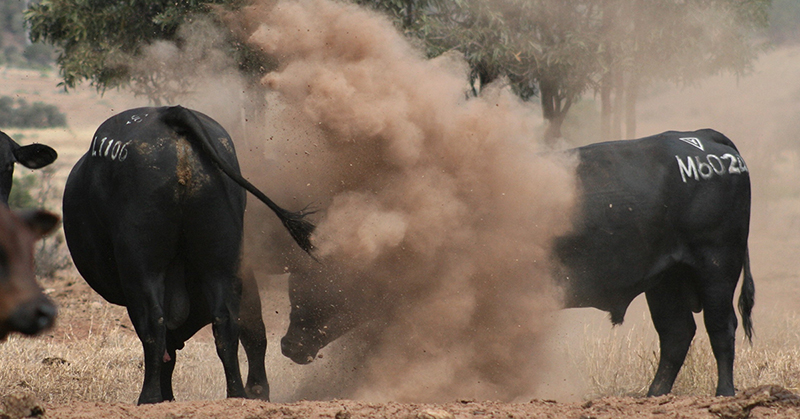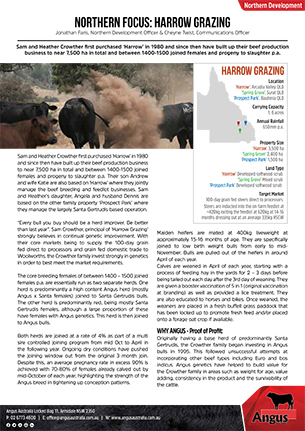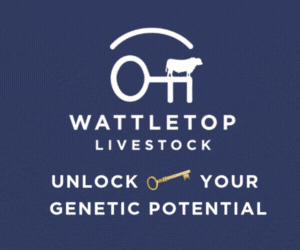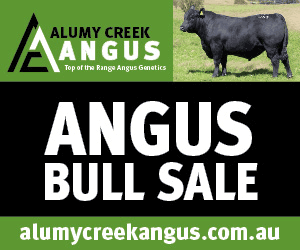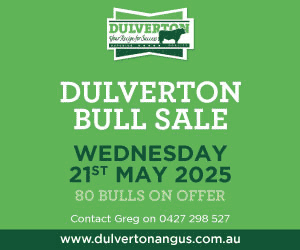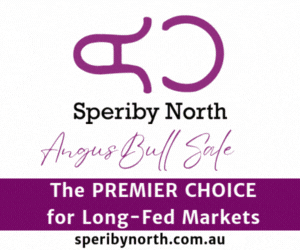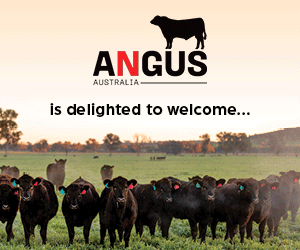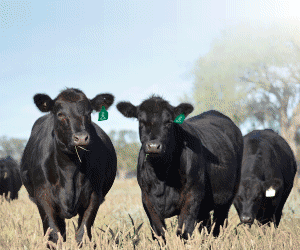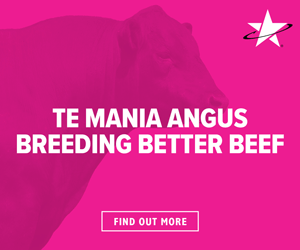Sam and Heather Crowther first purchased ‘Harrow’ in 1980 and since then have built up their beef production business to near 7,500 ha in total and between 1400-1500 joined females and progeny to slaughter p.a.
Sam and Heather Crowther first purchased ‘Harrow’ in 1980 and since then have built up their beef production business to near 7,500 ha in total and between 1400-1500 joined females and progeny to slaughter p.a. Their son Andrew and wife Katie are also based on ‘Harrow’ where they jointly manage the beef breeding and feedlot businesses. Sam and Heather’s daughter, Angela and husband Dennis are based on the other family property ‘Prospect Park’ where they manage the largely Santa Gertrudis based operation.
“Every bull you buy should be a herd improver. Be better than last year”. Sam Crowther, principal of ‘Harrow Grazing’ strongly believes in continual genetic improvement. With their core markets being to supply the 100-day grain fed direct to processors and grain fed domestic trade to Woolworths, the Crowther family invest strongly in genetics in order to best meet the market requirements.
The core breeding females of between 1400 – 1500 joined females p.a. are essentially run as two separate herds. One herd is predominantly a high content Angus herd (mostly Angus x Santa females) joined to Santa Gertrudis bulls. The other herd is predominantly red, being mostly Santa Gertrudis females, although a large proportion of these have females with Angus genetics. This herd is then joined to Angus bulls.
Both herds are joined at a rate of 4% as part of a multi sire controlled joining program from mid Oct to April in the following year. Ongoing dry conditions have pushed the joining window out from the original 3 month join. Despite this, an average pregnancy rate in excess 90% is achieved with 70-80% of females already calved out by mid-October of each year, highlighting the strength of the Angus breed in tightening up conception patterns.
Maiden heifers are mated at 400kg liveweight at approximately 15-16 months of age. They are specifically joined to low birth weight bulls from early to mid-November. Bulls are pulled out of the heifers in around April of each year. Calves are weaned in April of each year, starting with a process of feeding hay in the yards for 2 – 3 days before being tailed out each day after the 3rd day of weaning. They are given a booster vaccination of 5 in 1 (original vaccination at branding) as well as provided a lice treatment. They are also educated to horses and bikes. Once weaned, the weaners are placed in a fresh buffell grass paddock that has been locked up to promote fresh feed and/or placed onto a forage oat crop if available.
WHY Angus – Proof of Profit:
Originally having a base herd of predominantly Santa Gertrudis, the Crowther family began investing in Angus bulls in 1995. This followed unsuccessful attempts at incorporating other beef types including Euro and bos indicus. Angus genetics have helped to build value for the Crowther family in areas such as weight for age, value adding, consistency in the product and the survivability of the cattle.
Weight for age:
With the inception of their on-farm feedlot in 1992, now 650 head accredited, Sam estimates that by using Angus bulls, they increase the body weight in their Angus x Santa Gertrudis progeny by approximately 30kg per animal when finished, over non-Angus infused progeny.
This average weight advantage of 30kg / head is a significant factor in realizing on farm profit through the genetic potential of the majority Angus x Santa Gertrudis progeny through the feedlot. For example, using the median number of joined females’ of 1450 breeders at an ~87% weaning rate (90% preg test rate less 3% loss) is 1260 calves. Assuming 50% of the calf drop is a first cross Angus, then 630 head weighing an extra 30kg / animal when finished, potentially equates to an extra 18,900 kg return in actual beef over the year, excluding Angus infused cattle of less than 50% Angus content.
Alternatively, Angus infused cattle are run over a combined 5,900 ha (exc. ‘Prospect Park’), which equates to an extra 3.20kg of beef / ha / year. Andrew Crowther sums this up when he states,
“We aim to produce as much kilos of quality eating young beef as we can when we load cattle up the loading ramp”.
Value add:
The feedlot is used to value add with great effect and highlights the ability of Angus genetics to contribute to a readily saleable article. A draft of Angus infused #9 steers recently backgrounded on oats was inducted into the feedlot on the 4th September at ~410kg liveweight. These could have been marketed at today’s store prices of average $1,150/head.
However, 100 days on feed would likely look to return ~$2,000/head, less an approximate cost of $500/head for feed. Therefore, the return on the extra time and money spent on feeding Angus infused steers is well justified. As Sam states,
“Angus and Angus infused cattle help provide a saleable finished article at any stage of its life”.
Consistency of article:
Sam attributes the Angus breed with consistency of progeny, even in a crossbreeding program. Factors such as rib and P8 fat, marbling, muscularity and producing an overall even line of calves has translated into a more marketable item. In particular, the Angus bulls in Sam’s view “squares them up” in relation to the Angus x Santa progeny, which before using Angus bulls, progeny would be all growth and were often not as easy finishing.
Survivability:
Finally, the Crowther family is adamant that the Angus inject ‘survivability’ into the herd. Sam has observed many times, that when tailing out, the black weaners constantly have their
“heads down grazing as if it was like their last feed”, unlike the non-Angus infused weaners. This behaviour carries through the entire lives of the cattle, with the Angus x females being good foragers, subsequently raising strong, healthy calves. As Sam states, “Survival is in their DNA” when referencing the Angus breed.
Bull Selection:
Crucial to maintaining a fertile herd and meeting target weights and market specifications is their investment in genetics. Selecting bulls that have good confirmation, structurally correct so the bull can stride out to cover the distances, strong constitution as well as sound EBVs including 600-day weight greater than +100 and above average EMA (Eye Muscle Areas) EBVs are all non-negotiable factors. This is irrespective of whether the family purchases Santa bulls or Angus bulls.
However, the Crowther family also pay particular note of low birthweight EBV bulls. Indeed, the continual selection of low birthweight bulls and retained female progeny with those low birthweight genetics has meant that calving difficulty has been largely eliminated. Operating in extensive areas and with large numbers of cattle, it is impractical to continually monitor selected replacement heifers for any signs of calving difficulty. Therefore, bulls with low birthweight EBVs are sought out when attending Angus bull sales, particularly when joining maiden heifers.
Angus Australia acknowledges the funds provided by the Australian Government through the Meat & Livestock Australia Donor Company (MDC).
This resource was created as a result of a collaboration between Angus Australia and Meat & Livestock Australia Donor Company (MDC) (Project P.PSH.1063).

